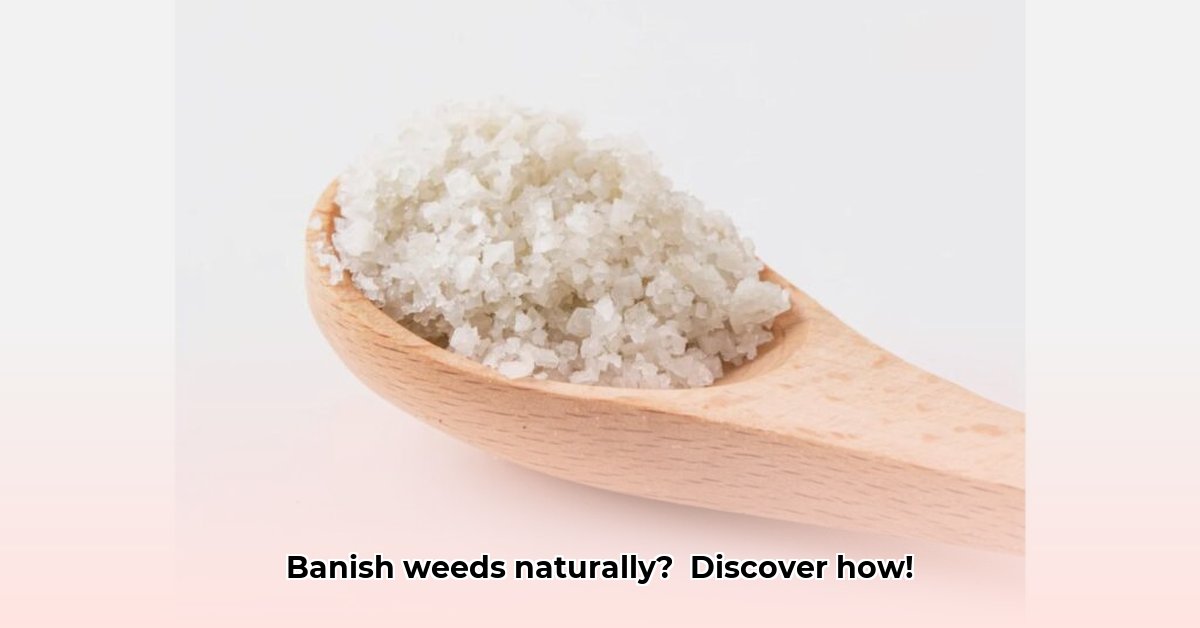Thinking about using salt to get rid of weeds? It sounds simple, right? Sprinkle some salt, and poof—no more weeds! But hold on. It’s not quite that easy. This guide will give you the straight facts on using salt to kill weeds, including the good, the bad, and the downright ugly. We’ll look at how well it works, how to use it safely (if you decide to use it at all!), and importantly, what the impact is on your garden and the environment. We’ll also show you some eco-friendly ways to tackle those pesky weeds, so you can have a beautiful garden without harming the planet. Essentially, we’ll help you decide if salt is the right tool for the job, or if there are better, greener options out there.
Salt for Weed Control: A Balanced Perspective
Let’s talk weeds. We all wish for a simple, easy way to banish those pesky plants from our gardens and walkways. Salt, readily available and inexpensive, often pops up as a seemingly quick fix. But is it truly a sustainable solution, or is it more trouble than it’s worth? Let’s explore the ups and downs to help you make the best choice for your garden and the environment with effective weed control techniques.
How Does Salt Actually Work to Kill Weeds?
Regular table salt, or sodium chloride (NaCl), works by creating a hypertonic environment around the plant roots. This means the concentration of salt outside the root is higher than inside the root. Through osmosis, water is drawn out of the plant’s cells in an attempt to equalize the concentration. This leads to dehydration, disrupting essential functions, causing wilting, and eventually, plant death. However, how well it works depends on several factors. The strength of the salt solution, how you apply it, the types of weeds you’re fighting, and even the weather all play a role in its effectiveness for natural weed suppression.
The Good, the Bad, and the Ugly of Using Salt on Weeds: Effective weed removal strategies
There are a few attractive aspects to using salt as a weed killer, but several significant drawbacks you should consider.
The Good (But Maybe Not So Good):
- Easy Access and Affordability: Salt is cheap and easy to find. You probably already have it in your pantry! This makes it a tempting choice for quick solutions. A standard 26 oz container of table salt costs only a few dollars.
- Spot Treatment Hero: For small, stubborn weeds, like those poking through cracks in your pavement or between patio stones, salt can be effective. It’s a targeted approach that avoids harming larger areas.
- The “Natural” Appeal: Some people prefer salt to harsh chemical herbicides, feeling it’s a more natural option. However, as we’ll see, “natural” doesn’t always mean harmless when considering organic gardening practices.
The Not-So-Good (and Sometimes Really Bad):
- Soil Damage: A Major Concern: Overusing salt seriously damages your soil. It disrupts the delicate balance of microorganisms, including beneficial bacteria and fungi, that make your soil healthy and fertile. High salt concentrations can lead to soil compaction, reducing drainage and aeration. It essentially poisons the very foundation of your garden, impacting overall soil health.
- Collateral Damage: Salt doesn’t just target weeds; it can harm desirable plants and beneficial insects or worms nearby. It’s indiscriminate, like using a sledgehammer to crack a nut. Sodium chloride is toxic to most plant life and can easily spread beyond the intended target area.
- Environmental Impact: Rain can wash excess salt into waterways, polluting rivers, streams, and even groundwater. This harms aquatic life and can have broader environmental consequences. Increased salinity in freshwater ecosystems disrupts the osmotic balance of aquatic organisms, harming fish, amphibians, and invertebrates.
- Effectiveness Varies Wildly: Don’t assume salt will always work. Its success depends on numerous factors, and some weeds are simply resistant. Deep-rooted weeds may not even be affected. Salt is most effective on annual weeds with shallow root systems.
- Sustainability Issues: The damage salt does to your soil often lasts a long time, making it difficult or impossible to grow plants in that area for a while. Soil remediation may be required to restore fertility, which can be costly and time-consuming. This directly contradicts the principles of sustainable gardening.
Using Salt on Weeds: A Cautious Approach (If You Must!)
If you’re determined to use salt, proceed with extreme caution and follow these steps:
- Start Weak: Begin with a diluted solution—think a small amount of salt in a lot of water. A 1:2 ratio of salt to water (one part salt to two parts water) is frequently suggested as a starting point. Gradually increase the concentration only if necessary, carefully monitoring the results. Avoid concentrations higher than 1:1, as this significantly increases the risk of soil damage.
- Precision is Key: Apply the salt solution directly to the weeds, using a spray bottle or a small brush to avoid contact with desirable plants or the surrounding soil. Consider using a shield or barrier to protect nearby plants from overspray.
- Monitor Soil Health: Regularly test your soil’s salinity levels using a commercially available soil testing kit. These kits typically measure electrical conductivity (EC), which indicates the amount of salt in the soil. Aim for an EC level below 2 dS/m (decisiemens per meter) for most plants. This helps you track the impact of the salt and adjust your approach accordingly.
- Consider Alternatives Seriously: Before you even reach for the salt, explore gentler, more sustainable options. Mulching effectively suppresses weed growth, and hand-weeding, though labor-intensive, avoids soil damage entirely. Organic herbicides also offer a less harmful alternative for weed control.
Comparing Salt to Environmentally Friendly Weed Control Methods: Exploring sustainable garden solutions
Let’s look at how salt stacks up against some more sustainable solutions:
| Method | Soil Impact | Effectiveness | Environmental Impact | Cost | Notes |
|---|---|---|---|---|---|
| High Concentration Salt | High | Variable | High | Low | Best for non-vegetated areas, requires careful application. |
| Low Concentration Salt | Moderate | Moderate | Moderate | Low | Requires repeated applications, potential for soil damage. |
| Vinegar/Salt Mixture | Moderate | Moderate | Moderate | Low | Vinegar (acetic acid) can also alter soil pH. |
| Boiling Water | Low | Moderate | Low | Low | Effective on annual weeds, requires caution to avoid burns. |
| Hand-weeding | None | High (labor intensive) | Low | High | Time-consuming but environmentally friendly. |
| Mulching | None | Moderate – High | Low | Moderate | Suppresses weed growth, improves soil moisture retention. |
| Organic Herbicides(e.g., WeedPharm) | Low to Moderate | Moderate to High | Low to Moderate | Moderate to High | Made from natural ingredients, generally safer for the environment and soil compared to synthetic herbicides. Always follow label instructions. |
Moving Forward: Protecting Your Soil and the Environment
While salt might seem like an easy weed-control solution, its long-term effects on your soil and the broader environment should be carefully considered. The risks associated with using salt often outweigh the convenience. Prioritizing sustainable practices that protect soil health and minimize environmental impact is undoubtedly the best path towards a thriving garden. Remember, there’s much ongoing research on weed control; new and improved methods are likely to emerge in the future. Stay curious and continue to learn about sustainable gardening practices to find what best suits your situation while understanding the environmental impact of herbicides.
How to Mitigate Salt Damage from Weed Control in Sustainable Farming
Key Takeaways:
- Soil salinization, a growing problem in agriculture, threatens crop yields and food security.
- Salt, while effective for weed control, carries significant risks to soil health and long-term sustainability.
- Understanding the limitations of salt as a weed control method is crucial for responsible farming.
- Sustainable alternatives to salt-based weed control exist and should be prioritized.
- Implementing integrated strategies, including soil testing, crop rotation, and careful irrigation management, are key to mitigating salt damage.
Understanding the Problem: Salt’s Double-Edged Sword
Salt is a powerful weed killer. Its effectiveness stems from its ability to dehydrate plants, essentially “drying them out.” However, this same mechanism damages the soil itself. Excessive salt builds up, altering soil structure, reducing water infiltration, and inhibiting nutrient uptake by beneficial plants. This is especially harmful in sustainable farming, which prioritizes soil health and long-term productivity. Increased salt concentrations lead to osmotic stress, making it difficult for plants to absorb water even when it’s available, highlighting the importance of sustainable agriculture practices.
Assessing the Risks: Is Salt Worth It?
Before using salt for weed control, carefully consider the potential consequences. The risks associated with salt’s use are significant:
Pros:
- Effective Weed Control: Salt rapidly eliminates weeds, offering
- Glass Tile Shower Ideas to Create a Stunning Bathroom Space - December 7, 2025
- Glass Wall Tile Ideas for Kitchens and Bathrooms - December 6, 2025
- Glass Tile Bathroom: Create a Beautiful, Easy-Clean Space - December 5, 2025










